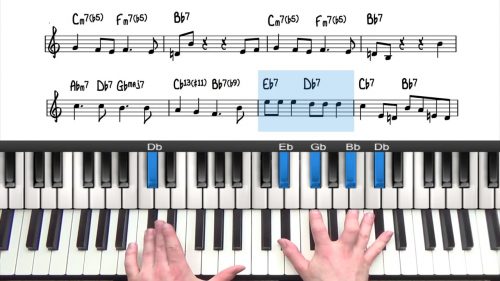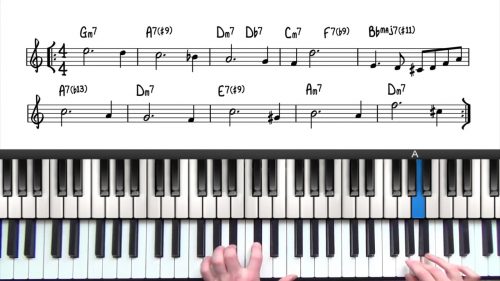Someday My Prince Will Come Tutorial
Despite the Disney connotations, ‘Someday My Prince will Come’ was a very popular tune with the jazz musicians of the 20^th^ century and continues to be played in jazz clubs, hotel lobbies and at weddings.
The form of the tune is four eight-bar sections: A, B, A, C. The A sections are identical, but the B and C sections have different harmonies and melodies. The song is also written in 3/4 making it a jazz waltz, and it’s usually played in the key of Bb major.
Notable recordings of the song include the Dave Brubeck version. He was the first jazz musician to record the tune. The Bill Evans and Scott LaFaro take on the 1960s album Portrait in Jazz is worth listening to. Also Miles Davis recorded the tune in the 1960s which is definitely worth checking out.
We’re going to start off with some simple left hand voicings and then up the tempo and add some bigger voicings for the second time through.







When will the transcription for this be available?
Hi there! Thanks for this lesson. I’m a bit confused about the second measure in the b section – when the right hand melody is playing an upper C, my real book has the chord marked as a B flat dominant 7, whereas in the lesson the B flat dominant 7 shows up above a D dominant 7. Could you explain how B flat dominant 7 and D dominant 7 relate to each other, and why they appear to be interchangeable?
Hi Ann,
Great question.
In this case the D7 can be seen as the V7 chord of G-7.
If we play G-7 over an Eb bass note, we have Ebmaj9, and so Eb major and G minor share a lot of common tones.
Of course the Bb7 is the V7 chord of Eb which is easy to explain, and due to the relationship outlined above we can also play D7 into Ebmaj7 which creates an interesting cadence and works particularly well here because we have Bb in the melody which is the #5 of D7, so it creates a very intersting flavour over the D7 chord.
Let me know if you have any further questions with that and enjoy the lessons!
Cheers,
Hayden
Hi Hayden! Another question – at minute 9:27 – you voice the F7 with a b9 (rather than just a 9) – it sounds great – but it wouldn’t have occurred to me to use the altered 9 there. Is there a rule behind your choice to use the b9? Or in other words is there something about the preceding notes / context around the F7 that would allow me to predict that the b9 would sound good there?
Thank you!
Hi Ann,
Great question.
The b9 just adds a little more colour and tension than the natural 9. The b9 is a very ‘soft sounding’ alteration and it’s one of my favourites to use.
Always pay attention to the melody note, if the melody note was the natural 9, then playing the b9 would create a clash.
Conversely, if we have the 3rd or 13 in the melody, the b9 will usually sound great as it can be applied in an upper structure triad. Think major triad off the 13th which gives 13-b9-3 as our upper structure triad tones. This would be a D triad over F7. In the case in this arrangement I am just adding the b9 as a single alteration and not a full upper structure triad.
Above anything else I would recommend experimenting. It takes just a moment to stop and try some different alterations over a dominant chord, and it’s exactly in that ‘moment of experimentation’ that we make little discoveries like this. When we stop and take the time to figure something out ourselves, you will find you retain the information better that way.
So always be curious when playing through jazz standards and think to yourself “what if I added….” to a specific dominant chord. It’s through the process of trial and error that we learn what works best.
I hope that helps Ann and let me know if you have any further questions with this.
Cheers,
Hayden
I loved the descending thirds you play over C#o7, Cm7, F7. If I saw your hands correctly you appear to start with fingers 4 2 (ring and index) and toggle to 3 1 (middle and thumb) all the way down. So what happens when you get to the F7 you’re using your thumb on black notes. That seems a bit unwieldly. I’m not sure I have a question exactly. I’ve been taught to avoid using thumbs on black notes unless there is no other way.
The ‘other way’ would mean switching to 5 3 (little and index) when playing B and G# over the F7 chord followed by 4 2 on A and F#, 1 3 on F and G# with 4 2 again on Eb and Gb. Also this fingering avoids having the thumb play on adjacent thirds at the very end. Does this make sense?
Speaking of fingering. I’ve also been taught to ‘use as many fingers as I can without thumbs on black notes’ when playing diminished scales. The half hole scale that starts on C makes sense to me (to avoid using the thumb on black notes.) But I’ve been practicing the other two diminished scales with a four fingered fingering shown in the picture I’m attaching. Is this considered wrong?
Hi John,
Great question here.
Yes you are correct that it’s best to keep the thumb off the black notes where possible.
There are some instances where this isn’t possible due to what is happening harmonically or the movement of the melody, but in general this is a solid rule to follow and it works 95%+ of the time.
I agree with your suggested fingering for the descending phrase in the tutorial. Sticking to the same fingering for diminished scales is something that I have been working on since recording this tutorial. Thanks for sharing your insights here.
Finally yes I feel that your 4 note fingering for the diminished scales is perfectly functional.
Often different musicians will have slightly different fingering methods and so there is no ‘one-size-fits-all’ with regards to fingering. Ultimately finding the fingering that is the most comfortable, memorable, and easy for you to execute should always be the top criteria.
I hope that helps John.
Cheers,
Hayden